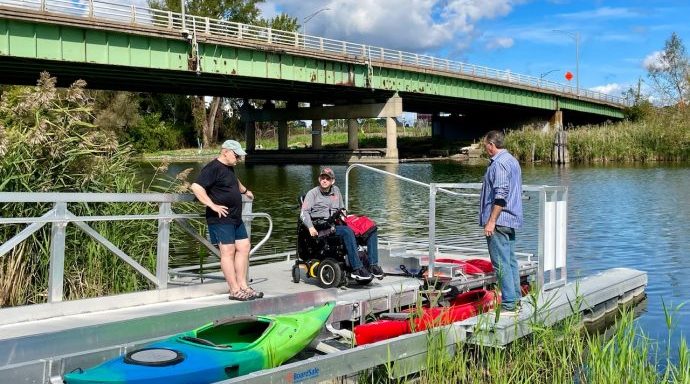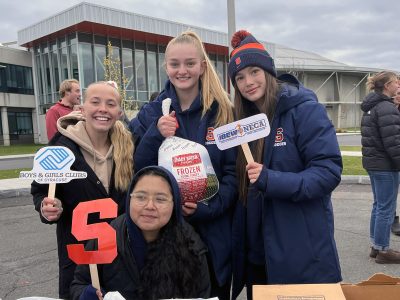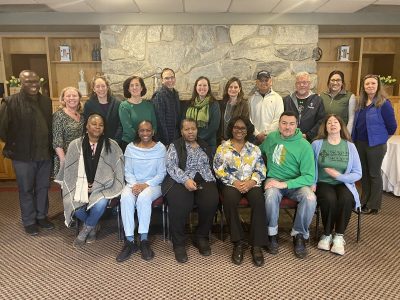Faculty, Students, City and Community Advocates Form Unique Accessibility Collaboration
In disability advocacy circles, the City of Syracuse has gained a national reputation as one of the most progressive cities in the U.S. for incorporating the ideas and feedback of users with disabilities when creating new handicapped-accessible spaces, according to two prominent disability advocates.
James (Cole) Galloway, Baylor University professor of physical therapy and founder of mobility design studio Go Baby Go, and Alex Truesdell, founder of the Adaptive Design Foundation and a MacArthur Foundation fellow, point to the work on Onondaga Creekwalk and the adaptive design circles here as a model for other communities to follow.
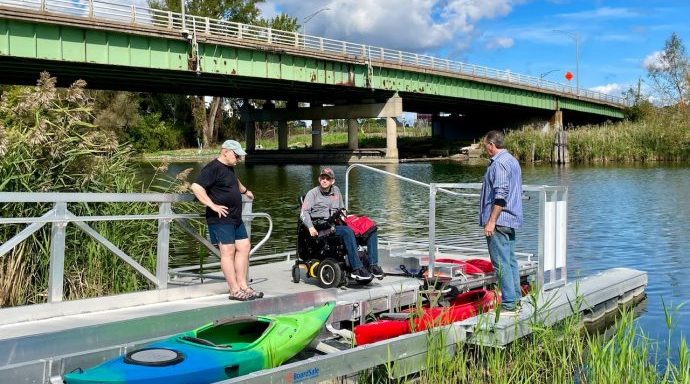
The Creekwalk is a 4.8-mile paved pathway that runs from the Southside neighborhood to Onondaga Lake. When city planners and engineers decided to make accessibility a major focus of the Creekwalk, they tapped into local individuals with a range of backgrounds—medical and social model disability advocates, inclusive design experts, students at Syracuse University and local individuals with disabilities. Russell Houck, a city facilities engineer, and Owen Kerney, City of Syracuse deputy commissioner of planning and sustainability, first invited local resident Connor McGough to provide a first-person perspective on the plans. McGough, a quadriplegic as the result of an accident at age 21, is the Adaptive Design program coordinator at ARISE Inc., a local independent living center.
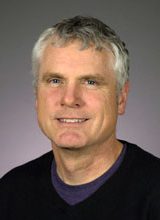
The project soon drew in others McGough knew: College of Visual and Performing Arts faculty members Don Carr, professor of industrial and interaction design, and James W.R. Fathers, professor and coordinator of the design M.F.A. program, who are both ARISE volunteers.
Also joining the group were Upstate Medical University developmental pediatrician Nienke Dosa and staff members from the Jowonio School, an inclusive preschool in Syracuse. Galloway and Truesdell were aware of the initiative through their involvement with the adaptive design community here.
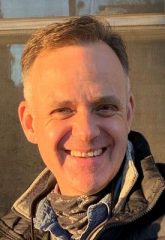
Carr involved School of Design master’s students because he recognized how the project presented an exceptional opportunity to learn inclusive design via a “living laboratory” at a site adjacent to their class space. He also knew the project supported key University goals for students: experiential learning; community-engaged scholarship; enhanced awareness of diversity, equity, inclusion and accessibility; and a commitment to human thriving.
The city’s project leaders welcomed student involvement, Houck says. “These projects are something we’ve collaborated on with Don Carr and with other organizations in the community. Our projects are better for it, and it’s wonderful we can have that resource. Carr is raising the profile of the work that’s being done and it’s great that he’s involving his students in these efforts.”
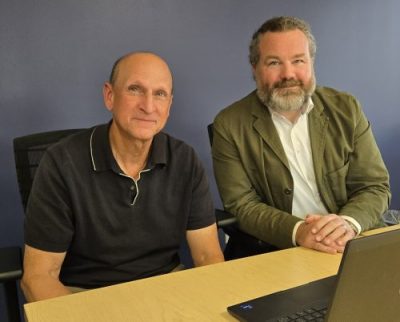
Kerney agrees. “Whether it’s the first fully inclusive and accessible playground, our sidewalks, our recreational amenities, boat launches or trails that are available to all users, increasing access is an important part of serving the entire community. It’s something Mayor Walsh and the whole administration has prioritized,” he says. “The city has a responsibility to serve everybody, and these types of improvements do just that.”
The User View
The student designers began determining how to create a practical experience at the Inner Harbor site based on the disability community maxim, “Nothing about us without us is for us.” Their first step: borrowing a wheelchair to look at the pathway from a disabled user’s perspective.
They digitally mapped the entire Creekwalk path, then started ideating. One student created a video game to familiarize users with the trail virtually before they visit. Another made an app that offers information about all pathway features. A third designed an accessible interactive information kiosk housing electrical ports to recharge electric wheelchairs. Others created an animation of the trail that featured a series of accessible kiosks, each equipped with a joystick controller for those with limited dexterity.
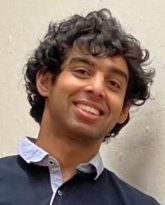
Amaan Khan ’23, a student who worked on that project and who is now a product and branding designer, said the class with Carr was “an absolute pleasure. It taught us that even though societal paradigms are shifting toward inclusivity, we must unlearn many of our ways to better connect people with disabilities to the facilities that already exist. Doing that can unite people and guide them forward as a collaborative community.”
McGough says he welcomed the chance to offer ideas based on his lived experience. “I was excited that they listened to my feedback and wanted to follow up on it, and that they were open to suggestions about accessibility in the community spaces,” he says.
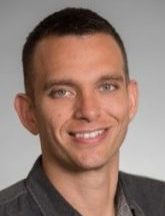
McGough was able to try the kayak launch last fall. It’s built so someone can comfortably transfer into and out of a boat via a bench, pull bars, hoists and a gradual rolling launch system. “I was so excited about this project. Getting out in the boat is such a great experience, getting some sun, being around water and nature, having some exercise and recreation,” McGough says. “It’s really freeing because once the boat is in motion, it’s all me making it happen. It’s a really nice thing to have when a lot of the time you require assistance from other people and aren’t able to feel so independent.”
Three Phases
The project has three access points—the kayak launch at the Inner Harbor and a wheelchair-accessible waterside access ramp at Kirk Park have been built. An access/launch point at Dorwin Avenue is planned as part of the third phase of the Creekwalk trail that is now under design.
A $70,000 grant from the Natural Resource Damage Assessment and Restoration program supported the Inner Harbor site, and $380,000 from the Honeywell remediation settlement, for improvements connected to Onondaga Lake, was used for the more extensive construction at Kirk Park. The city continues to apply for grants for ongoing accessibility projects.
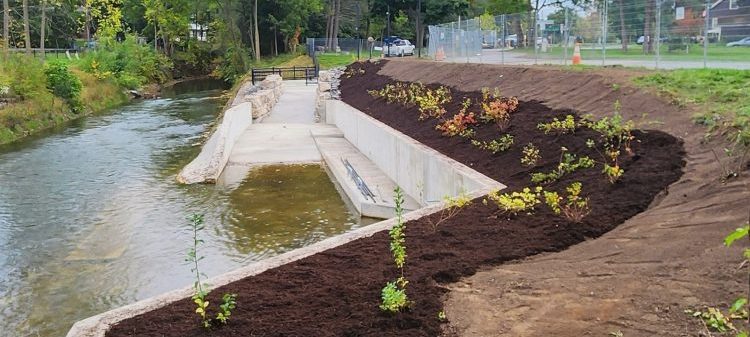
A Model Partnership
Working together came naturally to this group, so it’s unlikely they were aware of the “ripple effect” of their cooperation. Fathers believes the city’s openness to including disabled users from the start, the involvement of interested supporters and the inclusion of University faculty and students in the project helped the group gel. “The way the group came together was kind of an organic thing—because disabled people, designers and clinicians began working together in a matter of hours,” he says.
Fathers tells how Truesdell, who was involved in Syracuse’s adaptive design collaboration, referenced that coalescing as “the Syracuse effect”—something she said she had not seen previously in her experience, he says. “She means that in Syracuse, it’s very easy to connect to people with disabilities, their advocates, their families and designers in a way that she hasn’t seen in any other place. It’s all about the people here. She said it was a very powerful thing to observe,” Fathers says.
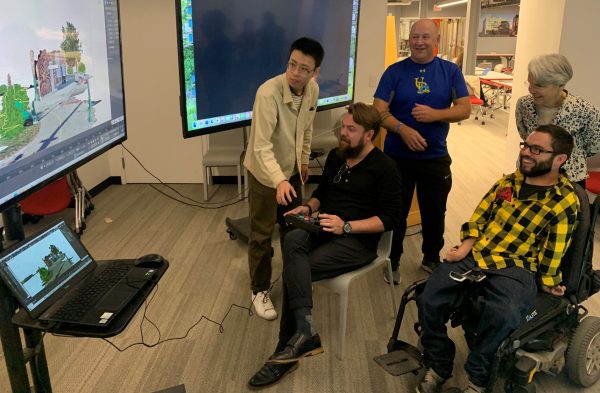
Galloway says the collective advocacy spirit here “is particularly rare. It’s a model the world needs to come here to look at to see what Syracuse does and how they continue it,” he says. “Where Syracuse jumps into the ‘I’ve never heard of this before’ category is that here, the people with the lived experience are the ones with the power. To step back and let the disability community lead and to have city planners listen and take direction from the folks having lived experience, that’s very unique. So many people in Syracuse break the mold—you’ve got a really radical set of individuals who, from the beginning of the idea, listened and believed and took action from the disability community.”
Hands-On Rewards
The hands-on learning students experienced was important to their training as designers, Carr says. “In teaching design, this is a great way to get students to co-design with individuals in our community to address real needs. Together, we’re able to build, test and modify these ideas on the fly. It’s very rewarding to work alongside someone and then see their immediate reaction vs. purchasing a product that, in the end, might not address their actual need.”
From an inclusive design standpoint having projects where faculty can jump in helps Syracuse be a leader in the accessibility space, and having an adaptive design focus is a major attractor for the University’s graduate design program, Carr says. “That’s because there are opportunities for students to do grant-based work as part of their studies and then apply ideas throughout their careers.”
